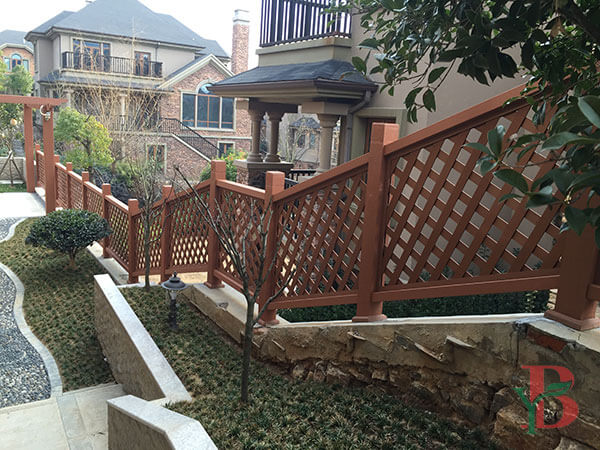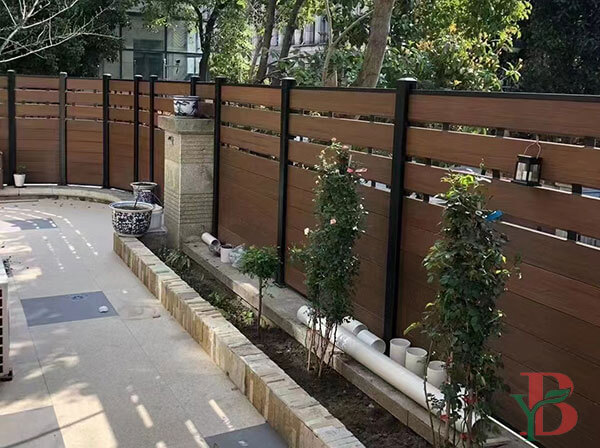When it comes to fencing options for your property, the debate composite fencing vs. traditional wood fencing often arises. Both materials have their own set of advantages and disadvantages, making it essential to weigh the factors that matter most to you. In this comprehensive guide, we’ll delve into the key differences between composite fencing and traditional wood fencing, helping you make an informed decision for your needs.
Key Differences: Composite Fencing vs. Traditional Wood Fencing
Durability and Longevity
Composite Fencing
- Highly resistant to rot, decay, and moisture damage
- Can withstand harsh weather conditions
- Superior insect resistance
- Maintains structural integrity long-term
Traditional Wood Fencing
- Susceptible to rot, decay, and insect damage
- Requires regular protective treatments
- May warp or crack over time
- Lifespan varies significantly based on maintenance
Maintenance Requirements
Composite Fencing
- Low maintenance
- No staining or painting needed
- Simple cleaning with soap and water
- Occasional inspection sufficient
Traditional Wood Fencing
- Regular maintenance required
- Periodic staining or painting needed
- Annual inspections recommended
- Repairs for damaged boards necessary
Aesthetic Appeal and Design Options
Composite Fencing
- Wide range of colors and styles available
- Modern, customized appearance options
- Can mimic natural wood appearance
- Various texture and pattern choices
Traditional Wood Fencing
- Classic, timeless appearance
- Natural wood grain patterns
- Can be painted or stained any color
- Traditional design appeal
Cost Analysis
Composite Fencing
- Higher initial installation cost
- Lower long-term maintenance expenses
- Reduced repair and replacement needs
- Better long-term value proposition
Traditional Wood Fencing
- Lower upfront installation cost
- Higher ongoing maintenance expenses
- Regular treatment and repair costs
- Potential early replacement needs
Environmental Impact Comparison
Composite Fencing
- Made from recycled materials
- Reduces demand for new raw materials
- Minimal environmental impact over time
- No need for chemical treatments
- Environmentally conscious choice
Traditional Wood Fencing
- Made from renewable resources
- Tree harvesting environmental impact
- Requires chemical treatments
- Shorter lifespan means more replacements
- Natural material benefits
Comparison Table: Composite Fencing vs. Traditional Wood Fencing
| Aspect | Composite Fencing | Traditional Wood Fencing |
| Durability | Highly durable and long-lasting, resistant to rot, decay, moisture, and insect damage | Prone to rot, decay, and insect damage |
| Maintenance | Low maintenance, no need for staining, painting or sealing | Requires regular maintenance, such as staining or painting, to protect from the elements and extend lifespan |
| Aesthetics | Available in a variety of colors and styles to complement any home’s exterior | Typically made from natural wood, which has a classic and timeless look |
| Cost | Higher initial cost, but lower long-term maintenance | Lower initial cost, but higher long-term maintenance |
| Environmental Impact | Made from recycled materials, making it a more sustainable option | Made from natural wood, which is a renewable resource, but harvesting trees can have a negative impact on the environment |
Frequently Asked Questions
Is composite fencing worth the extra cost?
While composite fencing has a higher upfront cost, its reduced maintenance needs and longer lifespan often make it more cost-effective in the long run.
Can composite fencing replicate the look of real wood?
Modern composite fencing offers highly realistic wood grain patterns and textures, making it difficult to distinguish from natural wood.
Is composite fencing easy to install?
Yes, Bongywood composite fencing is easy to install. You can use standard woodworking tools when working with composite. For more information view our fencing installation guide.
Does composite fencing & railing fade in the sun?
Composite fencing & railing will fade a little after it is exposed to the sun and undergoes the weather. During the first 3 months, the color may fade a little with a approximated percentage of 5% to 10%, this will not affect the overall effect. After that, the color will stay in a stable level through the lifetime of the product.
The anti-UV additives are added to reduce the fading and it will be much suitable for outdoor application.
Bongywood Composite Fencing – A SUSTAINABLE MATERIAL
Bongywood Composite Fencing-—Eco-friendly alternative to Wood Fencing
Approx. 90% Recycled materials, produced of recycled wood fiber and recycled plastic, which is a green energy saving & environmental protection product. Composite fencing offers a low-maintenance, durable fencing solution that doesn’t require painting or staining. Compared to traditional wood fencing, composite fencing is more resistant to rot, insects, and warping.


Bongywood Composite fencing, we offer a variety of composite fencing options. We will help you select the right fencing products for all of your needs. If you like the benefits that come from composite fencing, we are ready to work with you so that you receive the best results possible. For more information, please feel free to contact us.

Conclusion
Composite fencing offers many advantages over traditional wood fencing, including durability, low maintenance, and a variety of aesthetic options. However, it is typically more expensive than wood fencing. Traditional wood fencing is more affordable option, but it requires more maintenance and is not as durable as composite fencing. Ultimately, the best choice for a particular application will depend on the individual’s needs and budget.
Ready to Transform Your Property?
Contact a Bongywood representative today to learn more about our composite fencing solutions and find the perfect option for your needs.







